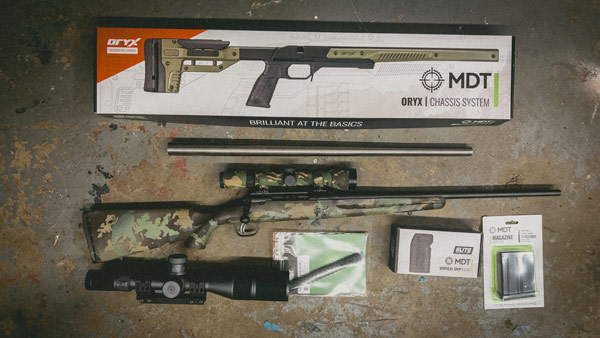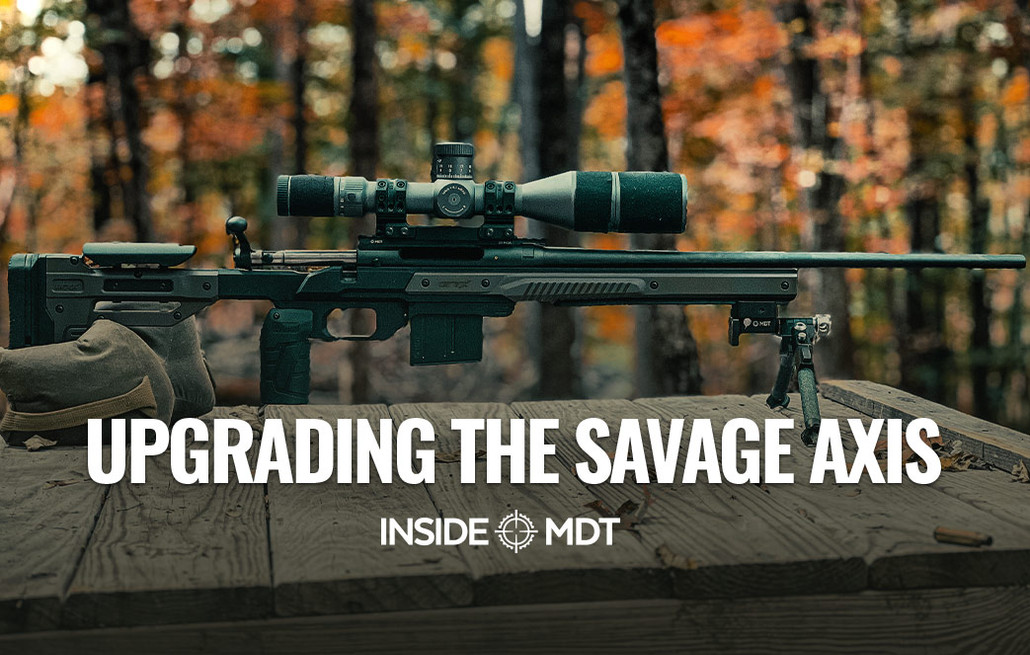Posted by William Maxwell on 2023 Dec 14th
Upgrading the Savage Axis - Inside MDT
Over the past few years, I have built several .223 Rem bolt guns for friends, never feeling the urge to own one myself—until I zeroed and developed a load for one. Since then, I've been looking for a .223 bolt face barreled action, action, or complete rifle within the right price range.
The goal was to stay budget-friendly yet remain a viable option for a PRS-style match. Given the current economy, finding something truly "cheap" is challenging, and .223 Remington 700s are relatively scarce. It was time to explore beyond my comfort zone. Fortunately, a close friend (shout out to Ranger Thom) had a Savage Axis he was willing to part with. After some negotiation, we agreed on a fair trade, and the rattle-canned Axis became mine.
For those unfamiliar, the Axis is a highly budget-friendly rifle with similarities to the Model 110 but notable differences. It employs the same size action for both long and short-action cartridges, an insert-style recoil lug like a Tikka, and an accu-trigger. The barrel utilizes a barrel nut, allowing for pre-fit barrels, although using a barrel nut isn't mandatory if turning a barrel blank.

Stock rattle canned Savage Axis
GATHERING THE PARTS
Given the Axis's limited aftermarket options, my chassis choices were narrowed down to the MDT LSS and the MDT Oryx. While the LSS suits a general precision rifle or .223 test platform, I sought something with more forend space for balanced shooting off barricades and accommodating a bipod. The Oryx perfectly aligns with the budget-friendly build requirements.We added a 10" Mlok ARCA rail, 20 MOA scope base, Elite Vertical grip, and a .223 mag. Tract Optics supplied a Toric ELR 4.5-30x scope for testing and evaluation, offering exceptional glass at a great value.The chosen barrel blank was a Shilen #7 with a 1:8" twist, paired with a .223 Wylde reamer from Manson Precision for versatility with heavy bullets.

FIRST TEST WITH FACTORY BARREL
The initial test aimed to establish a precision baseline. Dropping the original barreled action into the chassis and installing the optic, I had low expectations. However, with IMI 77gr Mod LR, both groups printed around 1/2 MOA—impressive. I considered calling it good and using the barrel blank for a different project. However, there was a challenge after firing ten rounds; a significant mirage emanated from the lightweight barrel. This was expected, given the nature of such barrels.

Adding a custom barrel increased the weight and tightened groups.
SECOND TEST WITH CUSTOM BARREL
Barrel work was straightforward once measurements were taken and a tenon print drawn. I opted for a 5/8x24 muzzle thread instead of the standard 1/2x28, providing compatibility with available muzzle devices. A thread protector and a well-cut crown replaced a brake. With the added weight of the 24" #7 pipe, the recoil was manageable, resulting in an overall unloaded weight of 18 lb 5 oz.
The rifle delivered tight groups at the range using 80 gr SMK handloads and Sig Sauer 77 gr OTM factory rounds. A note of caution: using handloads from a different rifle can pose safety hazards due to varying pressures. Once the rifle was zeroed, I shot a group of the 80 gr handloads. It printed a crisp 0.441" group. I'd say that's one hell of a way to start.
Since I plan on shooting Tac Class PRS matches with this next year, I'm focusing on 77 gr bullets. I shot two 5-round groups of the Sig OTM ammo while chronographing the velocities for future reference. They printed 0.427" and 0.524" with an average velocity of 2610 fps and a standard deviation of 15.7 fps. It's slower than I would like, but the barrel is far from settled. I'm curious to see what it's looking like after 150 rounds and a couple of deep cleans.

CONCLUSION
The project is off to a promising start, considering its origins. Over the next month, I'll focus on breaking in the barrel and load development. The Oryx has proven impressive, offering comfort and ample adjustment. While lacking MLOK slots on the sides of the forend for added weights and the option of mounting a 1913 rail, it represents incredible value.
Until next time, get out there and do some shooting.

BUILD ARTICLES FROM WILLIAM MAXWELL
- Building a Custom Bergara B14 for Competition
- Building A .223 AI Training Rifle
- Building a 308 Tikka Rifle
- Upgrading the Bergara B14
- Premium Lightweight Hunting Build
- Stumpy Rifle Short Barreled .308
- 338 Lapua: A Journey
- Inside MDT - Building a Custom Remington 700 in .308
- Building a 6mm GT for Competition
ABOUT THE AUTHOR
In 2018, William Maxwell fell into the rabbit hole of precision rifle shooting. He spends his free time competing, reloading, editing digital content, building rifles, and writing. He can be reached via Instagram @maddmaxxlop.


 CAD
CAD
 Euro
Euro
